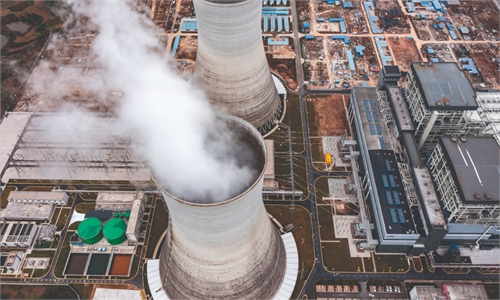China issues urgent notice, vows all-out efforts to win battle of autumn harvest against drought, heat waves

Battling intense drought and heat waves, local meteorological staffers in Huai'an, East China's Jiangsu Province, carry out rainmaking operations to increase precipitation across six spots in the city. Photo: CFP
With China issuing the highest heat alert for 12 consecutive days on Tuesday, four Chinese government departments including the Ministry of Agriculture and Rural Affairs (MOA) and Ministry of Water Resources jointly issued an urgent notice on reducing the impact of heat waves and drought on the country's autumn grain production.
South China is experiencing heat waves and dry weather with the longest duration, widest impact and largest average intensity since 1961, and the rapid development of drought combined with heat waves poses a severe threat to autumn grain production, according to a the notice published by the MOA on Tuesday.
The involved regions should deeply understand the significance of reducing the impact of drought on the autumn grain harvest and on social and economic development, resolutely shoulder the political responsibility to guarantee national food security, and make all-out efforts to win the battle of the autumn grain harvest against drought and heat waves, the notice said.
It said that water resources departments should strengthen the scientific management of rivers, lakes, reservoirs and other water resources to ensure the demand for agricultural irrigation water, and meteorological departments should promptly dispatch operational aircraft to severely drought-stricken areas and guide local governments in creating artificial rain.
On Sunday, the MOA held a meeting on autumn grain output, saying that heat waves and drought have become the biggest threats affecting the autumn grain harvest in South China, and dealing with the two factors to secure the autumn grain harvest was the primary task at present.
China continued to issue the highest heat alert on Tuesday, with parts of Central China's Hunan Province, Southwest China's Sichuan Province and Chongqing, and East China's Jiangxi Province experiencing temperatures as high as 40 C and above.
Li Guoxiang, a research fellow at the Chinese Academy of Social Sciences, told the Global Times on Tuesday that the heat-affected regions are the main rice production areas in China, and about 80-90 percent of China's rice seeding areas are in South China.
Globally, China is a major food producer and importer, and when food prices are still at high levels due to factors including the pandemic and the Russia-Ukraine conflict, ensuring China's grain harvest can not only reduce reliance on food imports, but could also contribute to stabilizing global food prices, Li said.
Rice is the largest food crop in China, accounting for about 40 percent of autumn grain production. Autumn grain crops account for three-quarters of the annual grain output across China, China News Service reported.
The impact of persistent drought on autumn grain production has sparked some worries on China's full-year grain output target in 2022 of 650 billion kilograms, but Li said that the drought will not affect the annual target, as the impact could be limited to a small scale with enough irrigation water.
But this year's abnormal weather reminds China to establish a long-term mechanism, as extreme weather may occur more frequently in the future.
In an interview with the Global Times in July, Lorenzo Labrador, scientific officer at the World Meteorological Organization's Global Atmosphere Watch Programme, said that he expected above-average temperatures all over the globe to become a trend.
"The reason is that, whereas heat waves are a normal atmospheric phenomenon, the increasing concentration of greenhouse gases in the atmosphere that cause the atmosphere to retain more heat makes heat waves more likely and its temperatures more severe. We have been seeing this trend for a number of years now and it is likely to continue".
Wei Ke, associate research fellow at the Institute of Atmospheric Physics of the Chinese Academy of Sciences, told the Global Times on Tuesday that he believed 2022 was the third year of a new era for the climate crisis, and human beings will embrace the fourth, fifth and more years of this era, with global warming pacing forward.
According to him, 2020 was the first year of this new era, as the world from the US to Australia was hit by wildfire, and locust swarms plagued East Africa, West and South Asia.
Wei said that future extreme disasters will come more frequently, and what's worse, they may come together, such as drought, flood and wildfire.
"In the future, we may face a combination of several disasters at a time. The influence could be much more severe," Wei said.
Abnormal weather will also be more severe and frequent, according to Li. He said North China was more frequently hit by drought and South China by flood in the past, but this year it is the opposite. Thus, both southern and northern China should prepare water resources facilities that can deal with both flood and drought, and also develop new types of crops to adapt.
Wei said that regarding the possibility of combined disasters, China should prepare an early warning system that could issue warnings one or two months in advance.





